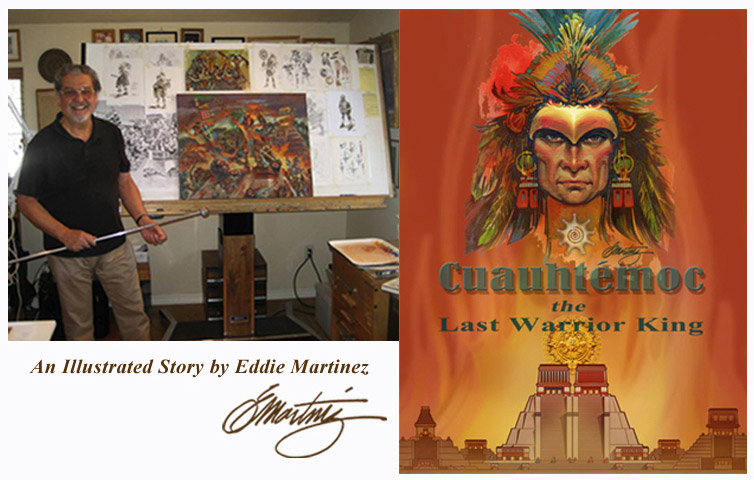Part 4 April 2015, Jerez de la Frontera, Cádiz
and the island of Tenochtitlán
By Eddie Martinez, Somos Primos article
ART, HISTORY & CULTURE:
Walking the streets of Spain while sketching and listening for voices from the past
Bv Eddie Martinez, edited and translated in Spanish by Viola Rodriguez Sadler

ARTE, HISTORIA & CULTURA:
Caminando por las calles de Espaha dibujando y escuchando las voces del pasado
Por Eddie Martinez, editado y traducido al espanol por Viola Rodriguez Sadler
Continuing with our tour through Andalusia, we took an all day bus tour from Sevilla to the Atlantic coast of La Frontera. Our first stop was in the Jerez wine country where we visited the famous Viñedos de Tio Pepe. We tasted their wines and enjoyed learning of their honored tradition in wine making. The facilities and environment were enchanting, especially the personally autographed and dated wine caskets of Spanish nobility and famous international artists from the past and present. Our next bus stop was to the arena of Spanish Andalusia horses where we watched the beautiful horses perform; unfortunately taking photographs was not allowed.
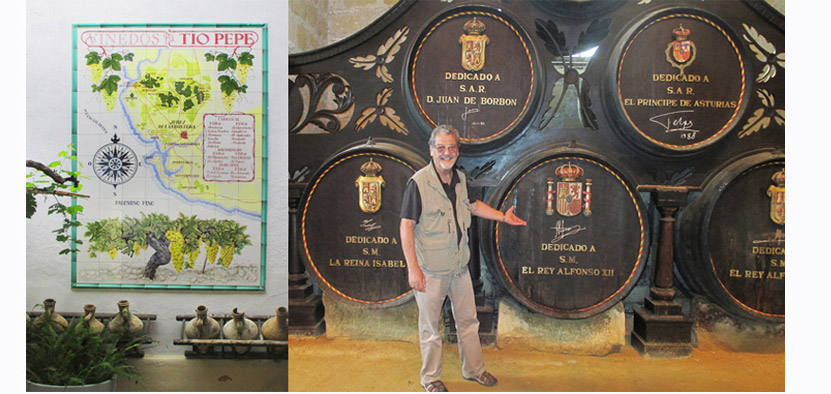
Continuando con nuestro recorrido a través de Andalucía, tomamos un tour de dia entero en autobús desde Sevilla a la costa Atlántica de La Frontera. Nuestra primera parada fue en el viñedo de Jerez, donde visitamos el famoso Viñedos de Tío Pepe. Probamos sus vinos y disfrutamos aprender de su tradición en la vinificación. Las instalaciones y el medio ambiente eran encantadores, especialmente los barriles de vino con fotos personalmente autografiados por la nobleza española y artistas famosos internacionales del pasado y el presente. La siguiente parada del autobús fue en la arena de los caballos españoles de Andalucía donde vimos los bellos caballos realizar su espectáculo; por desgracia no está permitido tomar fotografías.
Once again we were on our way to the Atlantic Ocean coast of La Frontera. Below left is a photo of the Río Guadalquivir as we crossed over it. As I looked across the broad river, I imagined a scene of fishing vessels coming and going and the merchant ships from Sevilla, full of supplies and men on their way to Spanish America. The photo on right is our friend Ettamae Carter, my sister, Irene Oropeza and Jessie when we arrived. The weather was pleasant and misty with drizzling light rain. We were told that it seldom rains in the southern region of Jerez de la Frontera.

Una vez más estábamos en camino a la costa del Océano Atlántico de La Frontera. Arriba a la izquierda está una foto del Río Guadalquivir cuando lo cruzamos. Mirando a través del gran río, me imaginé una escena de los barcos de pesca yendo y viniendo, y a los buques mercantes de Sevilla, llenos de suministros y a los hombres en el camino a la América Española. En la foto a la derecha esta nuestra amiga Ettamae Carter, mi hermana, Irene Oropeza y Jessie cuando llegamos. El clima estaba agradable, y con ligeras lloviznas. Nos dijeron que rara vez llueve en la región del sur de Jerez de la Frontera.
Once we arrived, I was very happy to finally be in the ancient port of Cádiz. Cádiz was founded around 1,100 B.C. making it the oldest city in the western world with a history of being home to the Phoenicians, Greeks, Visigoths, Romans, Moors, and the Catholic monarchy of Spain. Cádiz was the jumping off place for Christopher Columbus when he sailed west in search of Cathay. The two photographs below the photograph of Cádiz are of Jessie and me in the center of the historical Cádiz plaza where I was standing in La Frontera de Andalusia sorrounded by the magnificent 16th century Spanish Renaissance architecture. After returning home and looking through my photographs, I remembered Bernal Díaz del Castillo’s first person account of, The Discovery and Conquest of Mexico, and I began thinking of the lusty Spaniards and their yearning for fame, fortune and glory. Among these Spaniards were young Hernán Cortés, Pedro de Alvarado, Bartolomé de las Casas, Juan Rodriguez Cabrillo to name just a few.
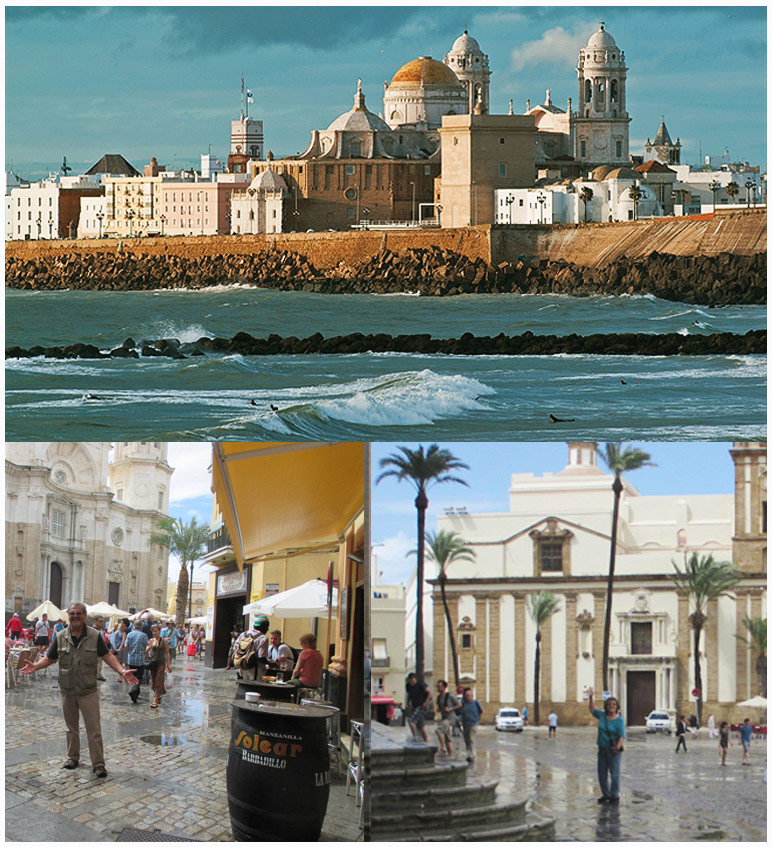
Ya que llegamos, me sentí muy feliz que por fin estábamos en el antiguo puerto de Cádiz. Cádiz fue fundado alrededor de 1.100 a.c. lo que la convierte en la ciudad más antigua en el mundo occidental. Tiene una historia de haber sido patria de los fenicios, griegos, visigodos, romanos, moros, y la monarquía católica de España. Cádiz fue el lugar de donde Cristóbal Colón se hizo a la mar cuando partió al oeste en busca de Catay. Las dos fotografías debajo de la fotografía de Cádiz son de Jessie y de mí en el centro histórico de la plaza gaditana donde yo estaba en La Frontera de Andalucía. Me encontré rodeado por la magnífica arquitectura del siglo XVI renacentista española. Después de regresar a casa y mirando mis fotografías, me acordé de lo que cuenta en primera persona, Don Bernal Díaz del Castillo en El Descubrimiento y la Conquista de México, y me puse a pensar de los codiciosos españoles y sus anhelos de fama, fortuna y gloria. Entre estos españoles estaban el joven Hernán Cortés, Pedro de Alvarado, Bartolomé de las Casas, Juan Rodríguez Cabrillo para nombrar sólo unos pocos.
I began by sketching the 17th century bell tower of the Iglesia de Santiago Apóstol that was built in 1647. Below next to my drawing is a photograph of the same Baroque Santiago Apóstol church.
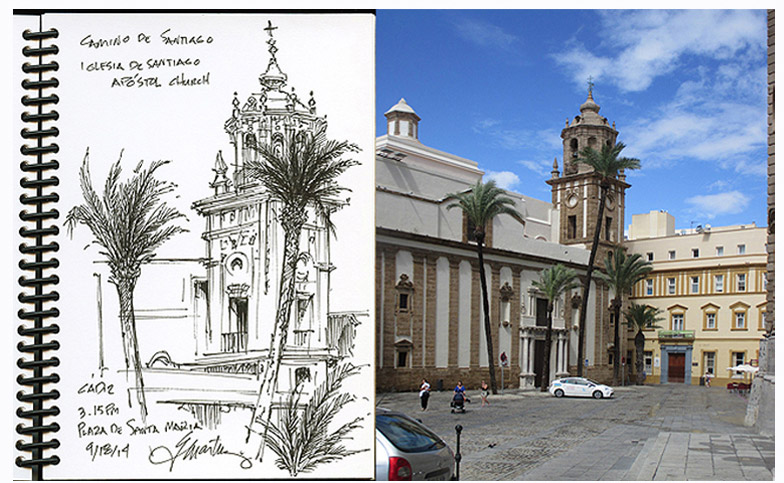
Comencé por dibujando la torre campanario del siglo XVII de la Iglesia de Santiago Apóstol que fue construida en 1647. A continuación junto a mi dibujo esta una fotografía de la misma iglesia Santiago Apóstol estilo Barroco.
Below, on the left is a photograph and on the right my sketch of the remaining ancient Roman wall with an arch, Arco de la Rosa that was later incorporated into a Moorish defensive wall. The whole ambience of this unique architecture in the grand plaza was a reminder of a period when seafarers, merchants, and the many wannabe mercenaries all crowded in these narrow streets seeking passage to the West Indies. Among those seeking passage were Spaniards, Germans, Flemings, Frenchmen, and Italians that came from all across Europe, including Blacks slaves from Africa, all gathered here in the bustling port of Cádiz.
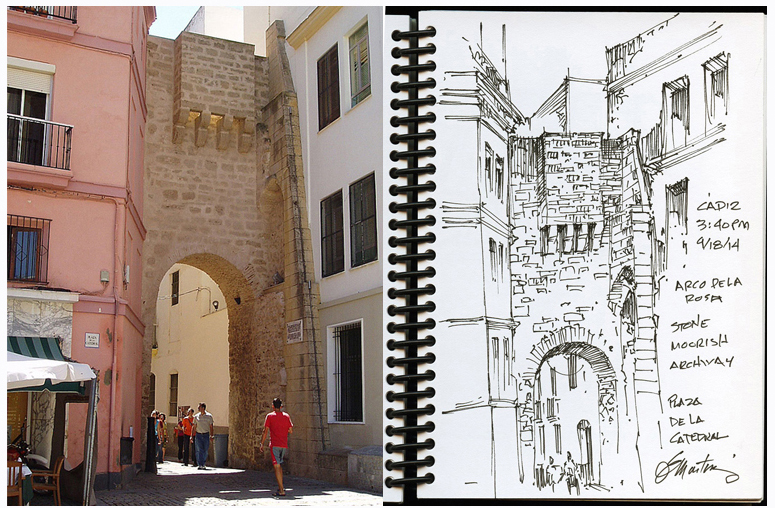
En la parte superior izquierda esta una fotografía y a la derecha mi dibujo del antiguo muro romano restante con un arco, Arco de la Rosa que más tarde fue incorporado en una muralla defensiva Moro. Todo el ambiente de esta arquitectura única en la gran plaza es un recordatorio de un período cuando los marinos, comerciantes, y muchos de los que quisieran ser mercenarios, todos hacinados en estas calles estrechas buscando pasaje a las Indias Occidentales. Entre los que buscaban pasaje había españoles, alemanes, flamencos, franceses e italianos que vinieron de todas partes de Europa, incluyendo los esclavos negros de Africa, todos reunidos en el bullicioso puerto de Cádiz.
I was thrilled to be sketching the Moorish fortress with the remains and ancient Roman building just behind. The tower facing the ocean barrier wall of the Atlantic may very well have been a lookout for observers looking to see ships on the horizon, friend and foe.

Yo estaba encantado dibujando la fortaleza Moro con los restos y el antiguo edificio romano detrás. La torre que da frente al muro barrera del mar del Atlántico puede muy bien haber sido un mirador para que los observadores vieran los buques en el horizonte, amigo y enemigo.
Map of Jerez de la Frontera and Cádiz: In the 15th century, Catholic Monarchs placed the city under the Spanish Crown, and so once again Cádiz rose to its greatness. Also, during this period King Felipe II ordered that walls surrounding the city be built.
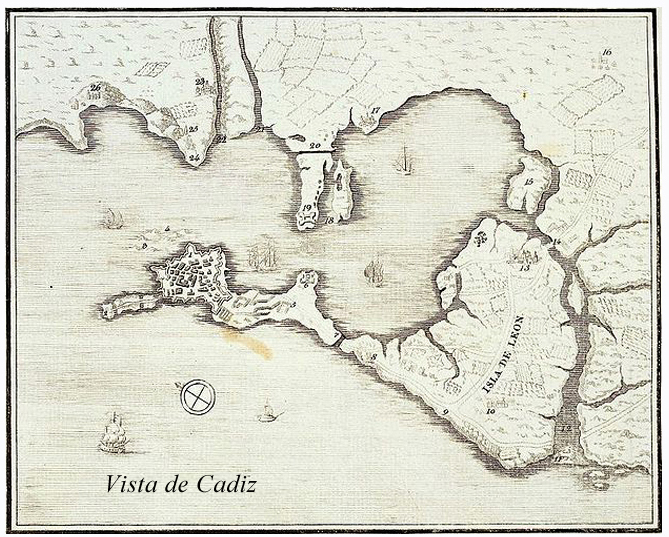
Mapa de Jerez de la Frontera y Cádiz: En el siglo XV, los Reyes Católicos pusieron a la ciudad bajo la Corona Española, y por eso una vez más Cádiz subió a su grandeza. También, durante este periodo el Rey Felipe II ordenó que los muros que rodean la ciudad se edificaran.
Below is the photograph of the Cádiz fortress, and below that is an artist’s rendering of the 16th century fortified harbor Havana Bay, and a photo of Havana fortress, as it exists today.
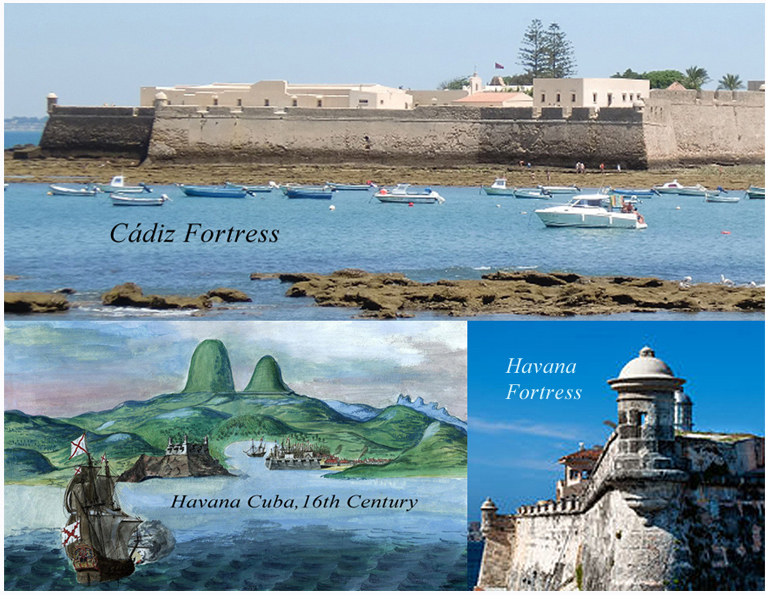
Arriba está la foto de la fortaleza gaditana, y a continuación esta una representación artística de la Bahía de La Habana fortificada en el siglo XVI, y una foto de la fortaleza La Habana, tal como existe en la actualidad.
Below is a drawing of my interpretation of Hernán Cortés on the Ixtlapalapan causeway standing before his loyal mercenaries troops and allied Tlaxcallan warriors awaiting the arrival of Moctezuma II or Moctezuma Xocoyotzin, the king of Tenochtitlán in the Valley of Mexico. Hernán Cortés was originally from Medellín, yet he spent most of his youth in Cadiz, Palos, Sanlucar and Sevilla, listening to the many tales of riches in the West Indies. At nineteen, Cortés sailed to Santo Domingo in Hispaniola and then on November 8, 1519 Hernán Cortés was standing here before his men, including his captain-general Pedro de Alvarado, and his chaplain Bartolomé de Las Casas, confident that he was about to fulfill his greatest ambition to conquer the most powerful and prosperous ancient civilization in North America.

Arriba se muestra mi interpretación de Hernán Cortés en el camino elevado Ixtlapalapan ante sus tropas fieles y aliadas y los guerreros Tlaxcallan mercenarios esperando la llegada de Moctezuma II o Moctezuma Xocoyotzin, el rey de Tenochtitlán en el Valle de México. Hernán Cortés originario de Medellín, pasó la mayor parte de su juventud en Cádiz, Palos, Sanlucar y Sevilla, escuchando los numerosas cuentos de riquezas en las Indias Occidentales. A los diecinueve años de edad, Cortés zarpó a Santo Domingo en Hispaniola y, a continuación, en el 8 de noviembre de 1519 Hernán Cortés se encontró aquí ante sus hombres, que incluyen a su capitán general Don Pedro de Alvarado, y su capellán Bartolomé de Las Casas, con la confianza de que estaba a punto de cumplir su mayor deseo de conquistar la civilización antigua más poderosa y próspera en América del Norte.
Another interesting character is Juan Garrido, an African slave. It is likely that Juan Garrido was sold to Portuguese merchants in Azemmour in North Africa and put aboard Portuguese ships that sailed to Lisbon. Juan somehow ended up in Sevilla where Juan was sold to a Spaniard named Pedro Garrido. Later in the West Indies, Pedro Garrido and his servant Juan Garrido participated in the assault and occupation of Puerto Rico and Cuba. When Hernán Cortés began his forced march from Vera Cruz to the island city of Tenochtitlán, Juan Garrido was among the troops. My drawings below are Juan Garrido on June 30, 1520, the Noche Triste or “The Night of Sorrows.” It was when Juan along with Cortés and his men were fleeing for their lives from the raging warriors from Tenochtitlán that Garrido managed to seize a fallen broadsword and began slashing his way to safety away from the causeway and the screaming warriors to rest beneath a large ceiba tree with Cortés and the survivors of the slaughter. This is how Juan Garrido won his freedom when Cortés gave him the honorary title of Conquistador by demonstrating his bravery against overwhelming odds.

Otro personaje interesante es Juan Garrido, un esclavo africano. Es probable que Juan Garrido fue vendido a los comerciantes portugueses en Azemmour en África del Norte y embarcó en los navíos portugueses que navegaron a Lisboa. Juan se encontró en Sevilla donde fue vendido a un español llamado Pedro Garrido. Más tarde, en las Indias Occidentales, Pedro Garrido y su esclavo Juan Garrido participaron en el asalto y ocupación de Puerto Rico y Cuba. Cuando Hernán Cortés comenzó su marcha forzada de Vera Cruz a la isla ciudad de Tenochtitlán, Juan Garrido se encuentra entre las tropas. Mis dibujos de arriba son de Juan Garrido en el 30 de junio de 1520, "La Noche Triste." Fue cuando Juan junto a Cortés y sus hombres se encontraban huyendo para salvarse sus vidas de los guerreros del Tenochtitlán ardiente, que Garrido logró apoderarse de un sable caído, y dando tajos a todo comenzó su camino a la seguridad alejándose del camino elevado y de los gritos de los guerreros para descansar debajo de un gran árbol de ceiba con Cortés y los sobrevivientes de la matanza. Así es cómo Juan Garrido ganó su libertad cuando Cortés le dio el título honorario de Conquistador, demostrando su valentía contra las adversidades.
The May article will conclude this series. In it I will continue to describe Cádiz as it relates to the Spanish characters and their encounters in the Americas and their encounters with Indigenous people of Tenochtitlán.
El artículo para el mes de Mayo concluye esta serie. Seguiré describiendo Cádiz en lo que se refiere a los personajes españoles y sus encuentros en las Americas y sus encuentros con los pueblos indígenas de Tenochtitlán.
Cuauhtémoc, the Last Warrior King
